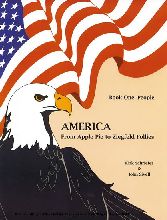Suchen und Finden
"D: Emily Dickinson (p. 19-20)
""Hope is the thing with feathers,"" wrote Emily Dickinson. One of America’s best-loved poets, Emily Dickinson often wrote verse about everyday things such as hope, birds, blue skies, flowers, people and death. But she displayed such a vivid and unique imagination that she seemed to get inside these things and see them in a new way.
The Dickinson family of Amherst, Massachusetts was well known. Emily’s grandfather helped to found Amherst College and her father was the treasurer. Emily was born in 1830, the second of three children. She began to write poetry in her teens. Emily received no formal training but over the years she continued to write. She would just write and write and write. Often she would sit up late at night when others were sleeping and let her imagination wander beyond her surroundings.
Emily Dickinson wrote extraordinary poems about things she had never seen and about places to where she had never been. The majority of her poems were short and untitled, written in four-line stanzas. Emily Dickinson never really got over her childhood shyness and as she grew older, Emily spent less and less time outdoors or in town. By the time she was forty she almost never left her house. People became very curious about her and were constantly trying to talk to her or see her. But Emily’s younger sister, Lavinia, always protected her. Emily only saw those D1 Perhaps because of this self-induced seclusion, Emily seemed to be able to give universal meaning to the most intimate human experiences and feelings. Her most important poems concern the relationship between the inner self and the external world.
Only six of Emily’s poems were published while she was alive. Her poems were the opposite of other popular works. Poetry in the 1860s was serious. Emily’s was light and witty. Sunrises, sunsets, shadows on the lawn, storms and bees were in her poems. But the sun did not just rise, it rose ""a ribbon at a time."" With Emily’s imagination, lightning displayed a yellow beak and ugly blue claws. Birds did not fly, they unrolled their feathers and rowed home. Emily Dickinson wrote most of her poems during the Civil War. Although she looked inward and not to the war for the theme of her poetry, the tense feeling of the war years may have contributed to the urgency of her writing. After the Civil War, Emily wrote less and less. And her later years were marked with sorrow at the deaths of family members and friends she dearly loved.
Why did Emily Dickinson choose to hide from the world and write all alone? Looking back at her extraordinary life, it seems that Emily’s idea of poetry was that before she could write about the world, she had to back away from it and contemplate it from a distance. Soon after Emily’s death in 1886, her sister, Lavinia, discovered a locked box that contained a treasure trove of over 1,700 poems. Lavinia pursued numerous publishers before the first collection, Poems by Emily Dickinson, was published in 1890."
Alle Preise verstehen sich inklusive der gesetzlichen MwSt.








